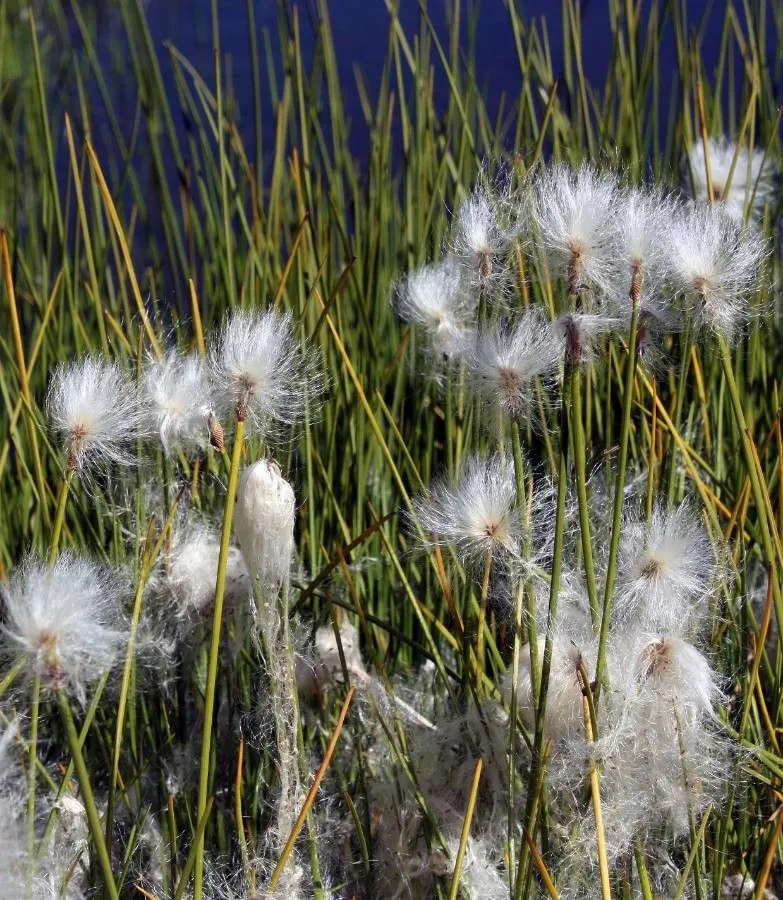
Author: Hoppe
Bibliography: Bot. Taschenb. Anfänger Wiss. Apothekerkunst 11: 104 (1801)
Year: 1801
Status: accepted
Rank: species
Genus: Eriophorum
Vegetable: False
Observations: Europe to W. Himalaya and Mongolia, Subarctic & Subalpine N. America
White cottonsedge, scientifically known as Eriophorum scheuchzeri, is an intriguing plant species belonging to the Cyperaceae family. First described by Hoppe in 1801 in the “Botanisches Taschenbuch für Anfänger und Wissende in der Apothekerkunst,” this plant has since captured the attention of botanists and nature enthusiasts alike due to its unique characteristics and widespread habitat.
Primarily found across a wide geographical range, white cottonsedge thrives in areas from Europe stretching to the western Himalayas and Mongolia, and can also be seen in the subarctic and subalpine regions of North America. Its adaptability to such diverse climates and landscapes highlights the plant’s resilience and ecological versatility.
The most striking feature of white cottonsedge is its cotton-like tufts that emerge from the plant’s flowering stems. These white, fluffy clusters are not only visually captivating but also serve a functional role in the plant’s reproductive cycle. They aid in the dispersal of seeds by catching the wind, ensuring that new generations of the plant can colonize suitable habitats.
White cottonsedge prefers wet, boggy environments and is commonly found in peat bogs, marshes, and along the edges of water bodies. It forms an essential part of these ecosystems, contributing to the biodiversity and the intricate balance of plant and animal life. The presence of white cottonsedge can be an indicator of the health of these wetland ecosystems, making it a species of ecological importance.
In addition to its ecological role, white cottonsedge has historically been used by indigenous and local communities. The plant’s fluffy seed heads were often utilized in traditional practices, such as the making of wicks for oil lamps, owing to their absorbent nature.
Overall, Eriophorum scheuchzeri is more than just a visually appealing plant. Its widespread presence across various regions, significant ecological roles, and historical uses underscore its importance in both natural and human contexts. This perennial perennial plant continues to be a subject of study for botanists and environmentalists seeking to understand the complexities of wetland ecosystems and the species that inhabit them.
Deu: scheuchzers wollgras
Eng: dense cotton-grass, shealted cotton-grass, white cottongrass, scheuchzer’s cottongrass, one-spike cottongrass
Sme: diehppeullu
Fra: linaigrette de scheuchzer
Swe: polarull, polar-ängsull
Nno: snøull, snømyrull
Nob: snøull, snømyrull
En: WHITE COTTONSEDGE, White cottongrass, Dense cotton-grass, Shealted cotton-grass, Scheuchzer’s cottongrass, One-spike cottongrass
Ca: Cotonera de Scheuchzer
Nl: Katoengras, Scheuchzer’s Wollegras
Fr: Linaigrette de Scheuchzer
De: Scheuchzers Wollgras
It: Pennacchi di Scheuchzer
Se: Diehppeullu
Nb: Snøull, Snømyrull
Nn: Snøull, Snømyrull
Sk: Páperník Scheuchzerov
Sv: Polarull, Polar-ängsull
Taken Aug 5, 2020 by Sébastien MOREAU (cc-by-sa)
Taken Jul 2, 2018 by Alain Roascio (cc-by-sa)
Taken Sep 12, 2019 by ulisse50 (cc-by-sa)
Taken Oct 17, 2021 by Bert Hentschel (cc-by-sa)
Taken Aug 9, 2020 by DELL’ANESE Stefania (cc-by-sa)
© copyright of the Board of Trustees of the Royal Botanic Gardens, Kew.
Taken Aug 6, 2020 by François Tricot (cc-by-sa)
Taken Jul 22, 2021 by Karl Jäger (cc-by-sa)
Taken Jul 26, 2021 by Thomas Rüegsegger (cc-by-sa)
Taken Aug 30, 2020 by euphrosiine M (cc-by-sa)
Taken Sep 5, 2013 by Reinhard Bachmann (cc-by-sa)
Taken Jul 18, 2020 by jerome calvin (cc-by-sa)
Taken Feb 19, 2022 by Christophe Maillard (cc-by-sa)
Taken Aug 12, 2011 by Tela Botanica − Yoan MARTIN (cc-by-sa)
Taken Jul 30, 2009 by Tela Botanica − Bernard SANIAL (cc-by-sa)
Taken Aug 26, 2022 by José Cuesta (cc-by-sa)
Taken Aug 11, 2022 by Lennaert Steen (cc-by-sa)
Taken Aug 21, 2018 by Philippe Guiral (cc-by-sa)
Taken Aug 23, 2020 by jack (cc-by-sa)
Taken May 22, 2020 by Celebration Power (cc-by-sa)
Taken Jun 26, 2020 by mauno (cc-by-sa)
Taken Aug 20, 2021 by Francois Mansour (cc-by-sa)
Taken Sep 13, 2022 by abeschin (cc-by-sa)
Taken Jul 15, 2007 by Photoflora – Benoit BOCK (©)
Taken Jan 1, 1800 by Tela Botanica − Thierry Pernot (cc-by-sa)
Taken Jul 1, 2003 by Tela Botanica − Françoise CARLE (cc-by-sa)
Taken Aug 12, 2011 by Tela Botanica − Yoan MARTIN (cc-by-sa)
Taken Aug 16, 2014 by Tela Botanica − Yoan MARTIN (cc-by-sa)
Taken Aug 16, 2014 by Tela Botanica − Yoan MARTIN (cc-by-sa)
Taken Jul 18, 2009 by Tela Botanica − Yoan MARTIN (cc-by-sa)
Growth habit: Graminoid
Ph maximum: 4.5
Ph minimum: 4.0
Light: 8
Atmospheric humidity: 9
Soil nutriments: 2
Family: Myrtaceae Author: (F.Muell.) K.D.Hill & L.A.S.Johnson Bibliography: Telopea 6: 402 (1995) Year: 1995 Status:…
Family: Rubiaceae Author: Pierre ex A.Froehner Bibliography: Notizbl. Bot. Gart. Berlin-Dahlem 1: 237 (1897) Year:…
Family: Sapindaceae Author: Koidz. Bibliography: J. Coll. Sci. Imp. Univ. Tokyo 32(1): 38 (1911) Year:…
Family: Asteraceae Author: A.Gray Bibliography: Pacif. Railr. Rep.: 107 (1857) Year: 1857 Status: accepted Rank:…
Family: Fabaceae Author: Medik. Bibliography: Vorles. Churpfälz. Phys.-Ökon. Ges. 2: 398 (1787) Year: 1787 Status:…
Family: Aspleniaceae Author: (Cav.) Alston Bibliography: Bull. Misc. Inform. Kew 1932: 309 (1932) Year: 1932…